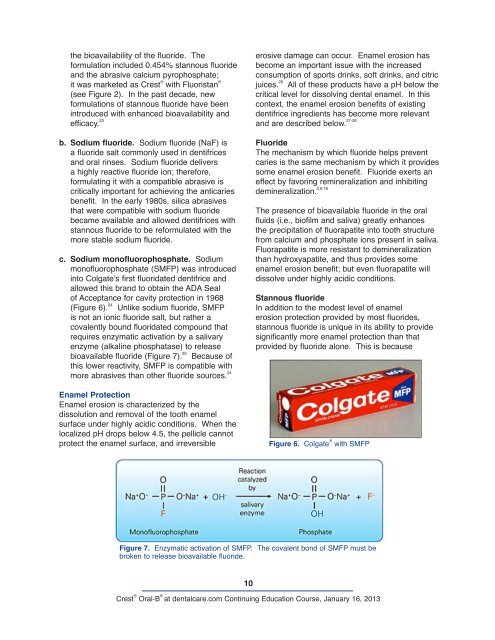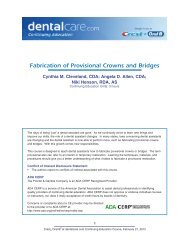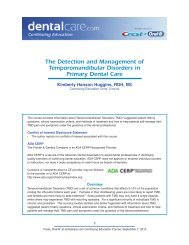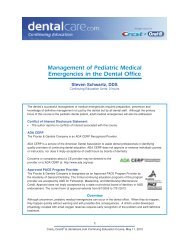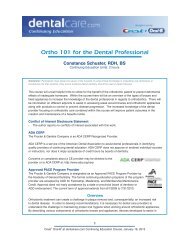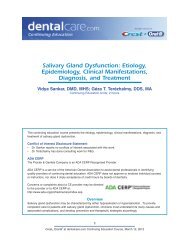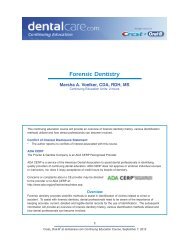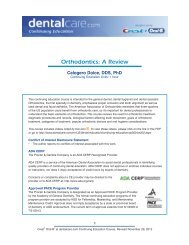CE410 - Fundamentals of Dentifrice: Oral Health ... - DentalCare.com
CE410 - Fundamentals of Dentifrice: Oral Health ... - DentalCare.com
CE410 - Fundamentals of Dentifrice: Oral Health ... - DentalCare.com
You also want an ePaper? Increase the reach of your titles
YUMPU automatically turns print PDFs into web optimized ePapers that Google loves.
the bioavailability <strong>of</strong> the fluoride. The<br />
formulation included 0.454% stannous fluoride<br />
and the abrasive calcium pyrophosphate;<br />
it was marketed as Crest ® with Fluoristan ®<br />
(see Figure 2). In the past decade, new<br />
formulations <strong>of</strong> stannous fluoride have been<br />
introduced with enhanced bioavailability and<br />
efficacy. 23<br />
b. Sodium fluoride. Sodium fluoride (NaF) is<br />
a fluoride salt <strong>com</strong>monly used in dentifrices<br />
and oral rinses. Sodium fluoride delivers<br />
a highly reactive fluoride ion; therefore,<br />
formulating it with a <strong>com</strong>patible abrasive is<br />
critically important for achieving the anticaries<br />
benefit. In the early 1980s, silica abrasives<br />
that were <strong>com</strong>patible with sodium fluoride<br />
became available and allowed dentifrices with<br />
stannous fluoride to be reformulated with the<br />
more stable sodium fluoride.<br />
c. Sodium mon<strong>of</strong>luorophosphate. Sodium<br />
mon<strong>of</strong>luorophosphate (SMFP) was introduced<br />
into Colgate’s first fluoridated dentifrice and<br />
allowed this brand to obtain the ADA Seal<br />
<strong>of</strong> Acceptance for cavity protection in 1968<br />
(Figure 6). 24 Unlike sodium fluoride, SMFP<br />
is not an ionic fluoride salt, but rather a<br />
covalently bound fluoridated <strong>com</strong>pound that<br />
requires enzymatic activation by a salivary<br />
enzyme (alkaline phosphatase) to release<br />
bioavailable fluoride (Figure 7). 25 Because <strong>of</strong><br />
this lower reactivity, SMFP is <strong>com</strong>patible with<br />
more abrasives than other fluoride sources. 24<br />
10<br />
erosive damage can occur. Enamel erosion has<br />
be<strong>com</strong>e an important issue with the increased<br />
consumption <strong>of</strong> sports drinks, s<strong>of</strong>t drinks, and citric<br />
juices. 26 All <strong>of</strong> these products have a pH below the<br />
critical level for dissolving dental enamel. In this<br />
context, the enamel erosion benefits <strong>of</strong> existing<br />
dentifrice ingredients has be<strong>com</strong>e more relevant<br />
and are described below. 27-29<br />
Fluoride<br />
The mechanism by which fluoride helps prevent<br />
caries is the same mechanism by which it provides<br />
some enamel erosion benefit. Fluoride exerts an<br />
effect by favoring remineralization and inhibiting<br />
demineralization. 2,9,16<br />
The presence <strong>of</strong> bioavailable fluoride in the oral<br />
fluids (i.e., bi<strong>of</strong>ilm and saliva) greatly enhances<br />
the precipitation <strong>of</strong> fluorapatite into tooth structure<br />
from calcium and phosphate ions present in saliva.<br />
Fluorapatite is more resistant to demineralization<br />
than hydroxyapatite, and thus provides some<br />
enamel erosion benefit; but even fluorapatite will<br />
dissolve under highly acidic conditions.<br />
Stannous fluoride<br />
In addition to the modest level <strong>of</strong> enamel<br />
erosion protection provided by most fluorides,<br />
stannous fluoride is unique in its ability to provide<br />
significantly more enamel protection than that<br />
provided by fluoride alone. This is because<br />
Enamel Protection<br />
Enamel erosion is characterized by the<br />
dissolution and removal <strong>of</strong> the tooth enamel<br />
surface under highly acidic conditions. When the<br />
localized pH drops below 4.5, the pellicle cannot<br />
protect the enamel surface, and irreversible Figure 6. Colgate ® with SMFP<br />
Figure 7. Enzymatic activation <strong>of</strong> SMFP. The covalent bond <strong>of</strong> SMFP must be<br />
broken to release bioavailable fluoride.<br />
Crest ® <strong>Oral</strong>-B ®<br />
at dentalcare.<strong>com</strong> Continuing Education Course, January 16, 2013


